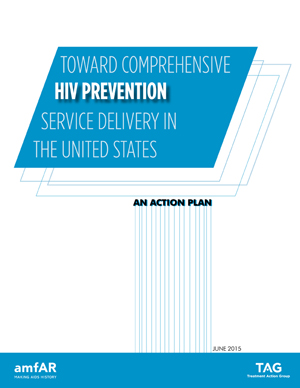June 24, 2015
From the Introduction
An objective of the National HIV/AIDS Strategy (NHAS), released by the White House in July 2010, is to lower the annual number of new infections in the United States by 25 percent by the end of 2015. Yet it is unclear if we will succeed in meeting this arguably unambitious target: 36,400 estimated new infections in 2015, compared with the 48,600 new infections estimated for the baseline year of 2006.
Our collective national prevention efforts have been unable to rein in an epidemic among gay and bisexual men and transgender women that, according to many indicators, is out of control. Available statistics are testaments not only to the severe shortcomings of U.S. prevention efforts, but also to the experience of individuals in vulnerable communities who live with the knowledge that many of their peers have a stigmatized and potentially lethal disease that is entirely preventable.
At the same time, there has never been greater potential for preventing new infections. The advent of biomedical tools to sharply curtail new HIV infection rates, along with emerging possibilities to more fully integrate HIV prevention services into systems of comprehensive primary care through provisions of the Affordable Care Act (ACA), presents tremendous opportunities to curtail new HIV infections, both generally and in vulnerable populations. The simultaneous arrival of new prevention science and a generally more favorable policy climate brings us to a long-awaited watershed—a time of unprecedented progress in national HIV prevention efforts.
There is, however, a great deal of work to be done. After nearly three decades of antiretroviral therapy (ART) development and refinement—including the emergence of data demonstrating that ART can nearly eliminate the risk of secondary transmission of the virus—less than half of all U.S. residents with the virus are fully engaged in clinical care, and only one-third have suppressed viral loads.
While an effective HIV care continuum has been developed to help identify gaps in the HIV response for people living with HIV, there are no similar population-based metrics or best practices in place to ensure that people who are HIV-negative—particularly those most vulnerable to the infection—remain so. Despite scientific evidence and expert opinion that pre-exposure prophylaxis (PrEP) can substantially reduce the risk of primary infection among vulnerable HIV-negative individuals, PrEP remains underpromoted and underused. Wraparound health strategies to minimize health disparities among key U.S. populations have developed as a result of the ACA; however, PrEP continues to be largely disconnected from these efforts. In states that continue to oppose Medicaid expansion, the challenges of receiving comprehensive preventive care are even more significant.
Treatment Action Group (TAG) and amfAR, The Foundation for AIDS Research, convened two consultations in 2014 to explore research and implementation priorities to expand comprehensive HIV prevention service delivery for vulnerable HIV-negative individuals and populations. In May, nearly 40 representatives from government, academia, service agencies, and affected communities gathered to review the current prevention tools for HIV-negative people and to identify priorities for successful access, uptake, and use under the ACA. A larger consultation of 60 leaders, nearly half representing vulnerable populations and subpopulations, focused on specific challenges and opportunities and worked to more clearly define a community-based research and implementation agenda.
This action plan, based primarily on the proceedings of the two consultations, seeks to define a communityfocused national strategy for integrating historically separate HIV prevention interventions and services— many with established positive effects on individual health outcomes—into needs-driven components of population-based care and support programs. Central to this effort has been the ongoing development of a comprehensive HIV prevention service delivery continuum to help galvanize stakeholders in much the same way that the continuum of care has done. Additionally, numerous research and implementation priorities of this plan were identified and discussed by consultation participants and are reviewed here.

